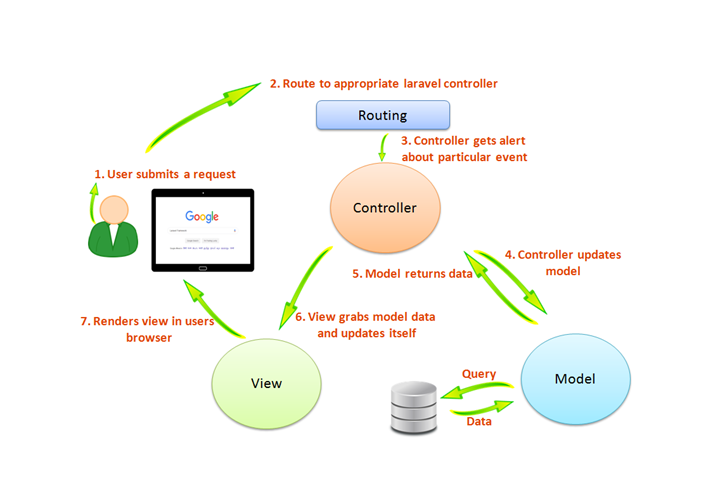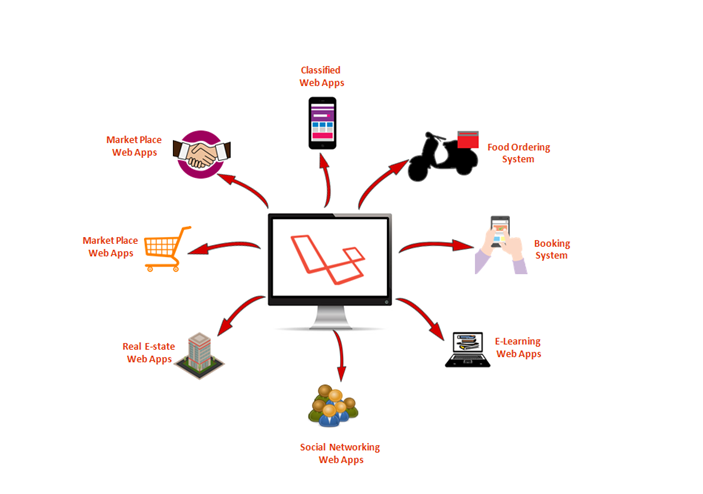Introduction
Laravel is a PHP framework that comes with lots of features that simply work out of the box. The biggest difference between other PHP frameworks and Laravel is that it is extremely easy to start and learn. Laravel is the most popular PHP framework today. Lots of projects run on production using Laravel. It is a PHP framework for constructing everything from small to enterprise-level applications. When you start using Laravel you are instantly going to love this framework with how easy it is to get started with. Laravel is completely free and open source, developers can fork the repository, make some customization, add new functionalities or packages and if everything is fine, those modules or packages are implemented in next Laravel version release.
Before I start introducing you to Laravel framework, let’s know first what a framework is.
Framework is nothing but a piece of code to help you provide basic functionality like, if you have a game framework then it will provide all the necessary code for your character to move jump etc. If you have a web framework then it will provide you basic functionality like database connectivity,form validation etc. so a framework basically helps you in many different ways to boost productivity of a program.
Now let’s start with Laravel, Laravel PHP Framework is built by Taylor Otwell in June 2011 with the focus of writing code syntax that is simple and expressive. This provides the advantage of having a Web Application that is developer friendly and code that is maintainable. Laravel framework was created to provide more advanced alternative to the CodeIgniter framework because CodeIgniter does not provide certain features like built-in support for user authentication and authorization.
Interestingly, Laravel has been improving year by year as per the version history of it. Each year new functionalities are implemented apart from the bug fixes.
Why Laravel is preferred?
As compared to other PHP frameworks, Laravel is highly used because Laravel gives quality output. It is an open source modern web application framework which quickly and easily designs customized web applications. Laravel is used for small as well as big projects.
Laravel offers high performance, best features and scalability; hence it is mostly preferred by developers.It uses Model View Controller (MVC) architecture which makes it more useful than PHP.
 MVC architecture diagram
MVC architecture diagram
If you go to see the graph from google trends, it clearly speaks about popularity of Laravel. Let’s deep dive into advantages Laravel provides over other frameworks.
Web applications that can be developed using Laravel.

Advantages of Laravel
- In-built Authentication
- Authorization Technique
- Object-Oriented Libraries
- Artisan CLI
- Security
- CSRF tokens by default
- Encryption
- Protected Routes
- Abstraction of code-base
- Database Migration
- Blade Templating Engine
- Automatic Package Discovery
- Eloquent ORM (Object Relational Mapping)
- Laracasts
Key Features of Laravel
- Modularity or Multi-app: Modularity is the degree to which a system’s components may be separated and recombined. You split of the business logic into different parts, which belongs together
- Authentication: Authentication is the most important part of any web application and developers spent enormous time writing the authentication code. Authentication has become simpler with this update in Laravel 5.
- Application Logic: Application logic can be implemented within any application either using controllers or directly into route declarations. Laravel is designed with privileges giving a developer the flexibility that they need to create everything from very small sites to massive enterprise applications.
- Caching: Caching is temporary data storage used to store data for a while and can be retrieved quickly. It is often used to reduce the times we need to access database or other remote services. It can be a wonderful tool to keep your application fast and responsive.
- Method or Dependency Injection: In Laravel, Inversion of control (IoC) container is a powerful tool for managing class dependencies. Dependency injection is a method of removing hard-coded class dependencies. Laravel’s IoC container is one of the most used Laravel features.
- Routing: Routing can be easily approached using Laravel. The route can be triggered in the application with good flexibility and control to match the URL.
- Restful Controllers: Restful controllers provide an optional way for separating the logic behind serving HTTP GET and POST requests.
- Testing & Debugging: Laravel is built with testing in mind in Fact, support for testing with PHPUnit is included out of the box and a phpunix.xml file is already setup for your application.
- Automatic Pagination: Simplifies the task of implementing pagination, replacing the usual manual implementation approaches with automated methods integrated into Laravel.
- Template Engine: Blade is a simple, yet powerful templating engine provided with Laravel. Unlike controller layouts, Blade is driven by template inheritance and sections. All Blade templates should use the .blade.php extension.
- Database Query Builder: Laravel’s database query builder provides a convenient, fluent interface to creating and running database queries.
- Command Line Interface:The command line interface called Artisan provides a way to interact with Laravel application. Artisan is mainly used to handle and manage the database migration, creating application skeletons, controller and model, etc. Artisan also helps in running queued jobs and scheduled commands. With the help of Artisan, we can perform many repetitive and time taking tasks comparatively faster.
- Multiple file system: Laravel 5 provides the native support for multiple file system. Laravel uses third party package Filesystem to provide multiple file support. You can use any of Local or Cloud based storage to provide simple configuration. You can configure storage options in config/filesystems.php file. You can also bypass all file system facade in the application and work directly disk facade.
- Packaging System:Laravel use composer as a dependency manager. In Laravel with the help of composer, we can easily install and manage the third party dependencies (or packages). This helps to save lot of time as compared to doing everything manually.Packages are great way to speed up your application development, they are freely available and you can use them to enhance your application functionality. You can also create and publish your own custom packages.
- Database Migration:It is very difficult to modify and share the application’s database schema. Migrations help you to keep the database in sync among development team or in sync among development machines. Laravel migrations are like version control mechanism for our database; you can simply create and manipulate tables using migrations.
- Middleware:Middleware is like a layer between a request and response, it provides a filtering mechanism for HTTP requests coming to your application. For example, Laravel has a middleware called Authenticate which verifies that the user is authenticated or not. If the user is not authenticated then he/she will be redirected to the login screen. However, if the user is authenticated, the middleware allows the request to execute.
How to install Laravel?
Follow the link for Laravel installation: https://laravel.com/docs/5.1/installation
Laravel requirements
Make sure your server meets the following requirements:
- PHP >= 7.1.3
- BCMath PHP Extension
- Ctype PHP Extension
- JSON PHP Extension
- Mbstring PHP Extension
- OpenSSL PHP Extension
- PDO PHP Extension
- Tokenizer PHP Extension
- XML PHP Extension
References: